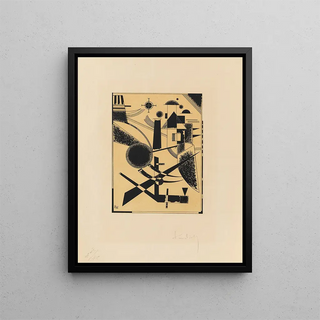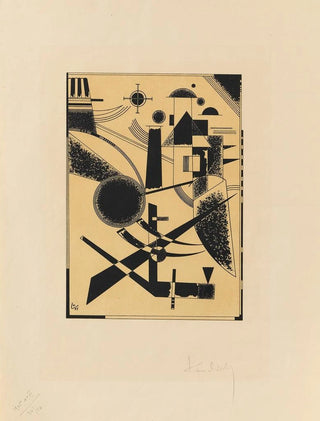Art print | Lithograph No. III - Wassily Kandinsky


View from behind

Frame (optional)
In the fascinating world of modern art, the "Art print n° III" by Wassily Kandinsky stands out for its boldness and depth. This piece, emblematic of the expressionist movement, invites viewers to immerse themselves in a universe where shapes and colors intertwine to evoke intense emotions. The art print, a printing technique that allows for highly faithful reproductions of artworks, becomes here the medium through which Kandinsky expresses his unique vision of reality. Every line, every shade, seems to vibrate with palpable energy, transporting the observer to the heart of an unforgettable aesthetic experience.
Style and uniqueness of the work
The "Art print n° III" is characterized by its distinctive style, where abstraction reigns supreme. Kandinsky, a true pioneer, abandons figurative representations to explore a new visual language, composed of vibrant colors and geometric shapes. This bold choice allows transcending reality and accessing a spiritual dimension, where art becomes a means of expressing the deepest emotions. The sinuous lines and bursts of color that make up the piece evoke perpetual movement, a dance between elements, creating an atmosphere that is both dynamic and contemplative. Every brushstroke, every hue seems to tell a story, that of an artist seeking harmony between the visible and the invisible.
The artist and his influence
Wassily Kandinsky, born in Russia in 1866, is often regarded as one of the founders of abstract art. His career, rich and varied, reflects a deep reflection on the nature of art and its role in society. Influenced by symbolism and fauvism, Kandinsky develops a unique approach, where each color and shape is charged with meaning. His work mirrors his spiritual and philosophical concerns, aiming to establish a link between art and music, two disciplines he considers intimately connected. Through his production, he inspires many artists and movements, leaving an indelible mark on art history. The "Art print n° III" is part of this

Matte finish

View from behind

Frame (optional)
In the fascinating world of modern art, the "Art print n° III" by Wassily Kandinsky stands out for its boldness and depth. This piece, emblematic of the expressionist movement, invites viewers to immerse themselves in a universe where shapes and colors intertwine to evoke intense emotions. The art print, a printing technique that allows for highly faithful reproductions of artworks, becomes here the medium through which Kandinsky expresses his unique vision of reality. Every line, every shade, seems to vibrate with palpable energy, transporting the observer to the heart of an unforgettable aesthetic experience.
Style and uniqueness of the work
The "Art print n° III" is characterized by its distinctive style, where abstraction reigns supreme. Kandinsky, a true pioneer, abandons figurative representations to explore a new visual language, composed of vibrant colors and geometric shapes. This bold choice allows transcending reality and accessing a spiritual dimension, where art becomes a means of expressing the deepest emotions. The sinuous lines and bursts of color that make up the piece evoke perpetual movement, a dance between elements, creating an atmosphere that is both dynamic and contemplative. Every brushstroke, every hue seems to tell a story, that of an artist seeking harmony between the visible and the invisible.
The artist and his influence
Wassily Kandinsky, born in Russia in 1866, is often regarded as one of the founders of abstract art. His career, rich and varied, reflects a deep reflection on the nature of art and its role in society. Influenced by symbolism and fauvism, Kandinsky develops a unique approach, where each color and shape is charged with meaning. His work mirrors his spiritual and philosophical concerns, aiming to establish a link between art and music, two disciplines he considers intimately connected. Through his production, he inspires many artists and movements, leaving an indelible mark on art history. The "Art print n° III" is part of this






